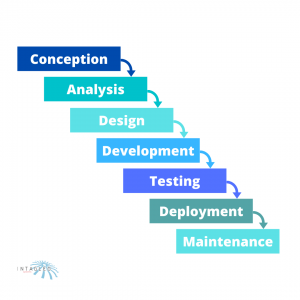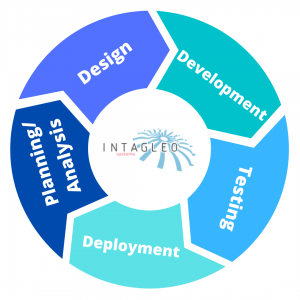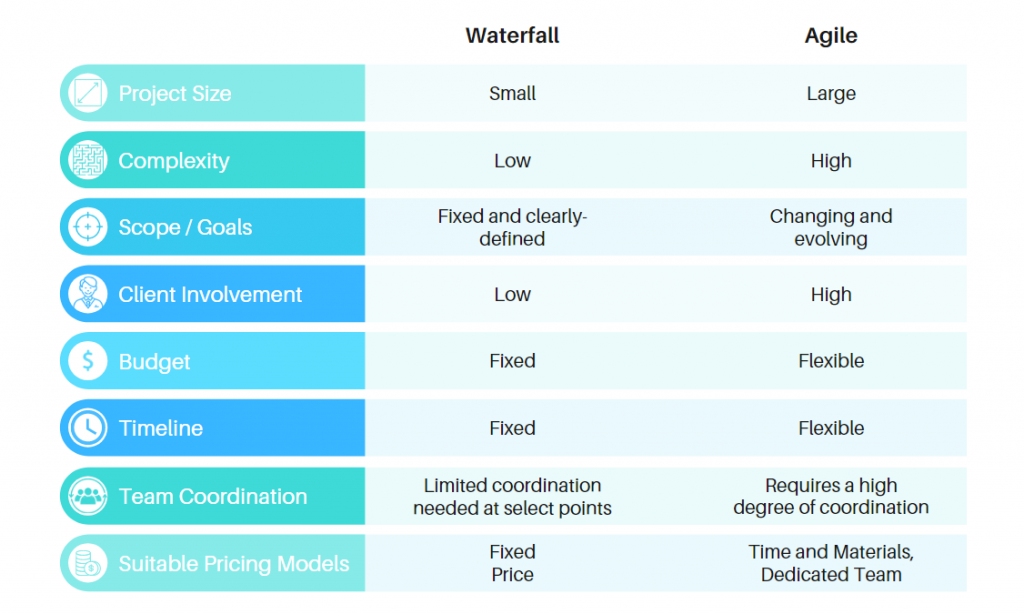Before embarking on any software development project as a team, the most important question you need to ask yourself is how you’ll actually go about executing it. Often, this boils down to two choices: Agile and Waterfall. While many will be quick to proclaim Agile as the better option, we would urge you to hold off judgment until all the facts are in.
Agile is clearly more popular than Waterfall. According to a 2019 report, about 97% of organizations are now practicing agile development methods. However, this isn’t just a popularity contest, and there are many other factors at play here.
In this article, we will delve into the Agile vs Waterfall debate, discuss their pros & cons, and try to understand which project management methodology is a good fit for you. So let’s begin!
What is the Waterfall Methodology?
Among the software development approaches in question, Waterfall is certainly the more conventional of the two. It is linear, sequential, and typically comprises multiple phases, where only when a phase is complete, does the software development team move on to the next one. Moreover, the team may need the client’s approval before progressing to the next one. The methodology also generally flows in one direction (hence the name), meaning the team can’t go back to a previous stage without starting over.
The Waterfall development phases look something like this:

Now let’s discuss each phrase briefly.
Conception
In this stage, the team does a quick assessment of the project, how they might go about executing it as well as the costs involved.
Analysis
The development team analyzes project requirements comprehensively, determines their feasibility, and documents all this information in a requirements document.
Design
Based on the documented requirements from the previous, the team prepares the system design. No coding takes place in this stay, and the team only decides what the final solution will look like and how they’ll go about realizing it.
Development
In this stage, developers leverage any algorithms and flow designed previously to create code that actually becomes part of the final product. The code is typically implemented in smaller pieces and then integrated.
Testing
With development out of the way, the code can now be tested for any errors or bugs. Testers may use manual or automated testing to identify any issues or faults.
Deployment
Once testing is complete and reported issues are resolved, the finished product is deployed to the customer for release.
Maintenance
Once the product is out in the wild, clients may encounter additional problems, and the development team may have to resolve them to ensure the product’s continual success.
Waterfall Methodology Pros
Clear Deliverables and Progress Tracking
Compared to most other models, Waterfall necessitates a clear understanding of deliverables, timelines, and milestones among both clients and the development team. With all parties on the same page with regards to the project scope, it’s not only far simpler to manage expectations, but also to measure and track progress.
The Waterfall methodology also employs a rather rigid structure where everything is carried out in phases, one after the other. This makes planning even more straightforward, especially if the project is simple and has fixed requirements and budget.
Outcomes Are More Predictable
Another benefit of having a fixed structure and agreed-upon requirements is that the development team has a clear sense of what the finished product is supposed to be like from the get-go. In such an ideal situation, there’s very little room for any deviation from what’s already been committed to the client, making the final product more predictable and in line with the customer’s expectations with regards to both feature-set and delivery time.
All Team Members Are Not Needed All The Time
Not all resources have to be engaged throughout the entire duration of a project. They will only have to work in certain phases of the project during which their services are required. For example, only Business Analysts need to be present during the Requirements Gathering phase, freeing up developers and Quality Assurance Engineers to focus their time and attention elsewhere.
Easy to Understand
The Waterfall model’s sequentiality makes it fairly straightforward and easier to comprehend and adopt than Agile. This means most development teams can dig into waterfall development right away without requiring any prior training or getting the hang of new principles. Moreover, since requirements and deliverables are fixed and predictable, management is simpler, and teams don’t need to be constantly on the lookout for any curveballs coming their way.
More Focus On Documentation
Waterfall necessitates comprehensive documentation throughout the project’s lifecycle, ensuring vital information is conveyed seamlessly between different parties involved in each of the phases. This is extremely vital as any gaps in communication and misunderstandings can be detrimental to timelines and project quality.
Besides quickly bringing the team up to speed on the project’s particulars, documentation also promotes better understanding and allows for better planning.
Requires Minimal Customer Involvement
With the Waterfall methodology, the client doesn’t need to keep their hands on the steering wheel at all times. After the initial requirements gathering process, there’s very little customer involvement required, especially since the project scope is fixed and changes are unlikely. Therefore, this approach is great for projects with clear, unchanging goals and customers who don’t want to be very hands-on throughout the development process.
Waterfall Methodology Cons
Changes Can Be Costly and Difficult
Owing to its sequential structure, the Waterfall Methodology favors predictability over flexibility and works best when the project requirements are clearly defined and fixed. Once a particular phase has been completed, the development team can’t revisit it if any issues that pop up downstream until the testing phase. By then, development is practically complete, and going back to fix anything often proves difficult and expensive.
Testing Often Suffers
As discussed, the testing phase follows development in Waterfall. Since you can’t test on the fly, most of the bug fixing is typically left for the very end. While this can be an issue on its own, it’s further exacerbated if phases before testing start falling behind as the project still needs to be completed on time. Any delays in design and development usually mean testing has to be rushed to meet deadlines, allowing bugs to fly under the radar and leading to a subpar final product.
Hard to Gather Accurate Requirements
To guarantee a project’s success, nailing down the customer’s exact requirements is a must. However, this is easier said than done, especially if the customer is unable to furnish sufficient details or if their needs are subject to change. This paves way for assumptions, misunderstandings, and eventual disappointment.
Lack of Customer Feedback May Cause Dissatisfaction
In waterfall development, customers are only engaged during initial project scoping and requirements gathering, and don’t get to see what’s actually being developed until after several phases. While some customers may breathe a sigh of relief at the thought of not having to be super-involved throughout, others may find being kept in the dark a bit frustrating.
Moreover, since there’s not much they can do to provide feedback or clarify their position, the final product may fall short of their expectations, leaving them even more dissatisfied with the overall experience.
What is the Agile Methodology?
Agile is an iterative and incremental approach to project development that focuses heavily on teamwork, rapid delivery, and adaptability. Unlike Waterfall, where the entire project needs to be laid out before development can begin, Agile breaks down the overall project into smaller, more manageable units and prioritizes delivering critical or foundational features.
Principles of Agile
To fully comprehend what Agile is all about, we need to know the principles that define it. Based on the Agile Manifesto, these can be summed up as follows:
- Early, continuous, and frequent delivery of functioning software
- Adaptability and flexibility to evolving needs
- Effective collaboration, communication, and team empowerment
- Lean development
- Sustainable, quality-driven development and continuous improvement
Scrum
Based on these principles, Agile can manifest itself in several ways, such as Scrum, Kanban, and XP. In this article, however, we’ll be solely focusing on the Scrum model. (Stay tuned if you want to learn more about Kanban and how it compares to Scrum. We’ll discuss that in a future article).
In Scrum, the overall project is broken into time-boxed sprints. The team’s object for each sprint is to plan and implement deliverables, as prioritized by the client. Sprints enable them to quickly develop portions of the project which they can concurrently test as well as release to clients for feedback. Thus, there’s plenty of room for changes and reprioritization of work. Feedback and lessons from a given sprint inform the ones that follow.
The figure below shows the Agile Development Cycle.

The phases in a typical Agile cycle are quite similar to the ones in Waterfall. However, unlike Waterfall, these need not be sequential and can also happen concurrently.
Here’s how an Agile team usually goes about development:
Planning and Analysis
After an idea is conceived and deemed feasible, the development team and the client take part in a planning meeting at the start of a sprint to discuss business requirements and product features. Together, they select high-priority features that the team feels they can commit to delivering in a single sprint.
Design
Based on deliverables and actionable items for the current sprint, the team prepares the system design. Just like Waterfall, only flows and algorithms are developed in this phase, and no actual coding takes place.
Development
The features are materialized through programming. The first iteration lays the foundation for the project, and additional features are incorporated in future iterations.
Testing
After development, the project is tested stringently and evaluated against set criteria for the sprint to ensure it’s in line with customer expectations.
Deployment
At the end of a sprint, completed features are packaged and released to customers. There are reviews or demos in which teams demonstrate functionality to stakeholders as well as Retrospectives in which teams evaluate and learn from their performance during the sprint. Suggestions and feedback obtained, along with new requirements and incomplete items inform the agenda for the next sprint. The entire process is repeated until the product is complete.
Pros of the Agile Methodology
Accommodates Change
Agile not only anticipates changing customer needs or priorities, but it also embraces them. Its inviting and iterative nature makes it easy for clients to request changes at any time during the project and for developers to incorporate them in subsequent sprints without detracting them from the task at hand. This is especially helpful in long-term projects, where customers gain a better understanding of what they want they want out of their products as development progresses, making change inevitable.
Encourages Customer Involvement
Frequent client-team communication is inherent to the Agile methodology, allowing the customer to provide constant feedback and more effectively steer the final product towards their vision. Such a customer-driven approach ensures developers can satisfy client needs, even if they’re constantly changing, and forge stronger, more meaningful relationships with them as a result. From the customer’s perspective, direct collaboration and engagement with the team make them feel heard and instills in them a sense of ownership that would be unlikely if they went with a more hands-off approach like Waterfall.
Reduces Time to Market Without Compromising On Quality
If the product needs to be out the door as soon as possible, Agile is a better option as it lets developers build iteratively, allowing them to roll out high-level or high-priority features quickly in an earlier build. This means that customers can stay ahead of their competition by providing a functioning, albeit a basic version of their innovative product to users.
However, there are no compromises on quality as rigorous testing, customer feedback, and value-addition enable the development team to flesh out and perfect the product in subsequent iterations.
Provides More Opportunity For Learning and Improvement
In Agile, each project iteration is followed up by a final sprint review, where the team gets together and discusses any setbacks or challenges they faced and what can be done to meet them more adequately in the future. Thus, even mistakes have value as lessons learned from one sprint can be applied to future ones as the team continually improves themselves to deliver more robust software, faster.
Enforces Strong Team Collaboration
Collaboration and team synergy take center stage in an Agile environment. All team members bring unique skills to the table and need to work concurrently throughout the project. Without effective self-organization and communication, it’s virtually impossible to deliver a quality solution in a timely fashion. Therefore, team members take charge of aspects of the project relevant to their expertise, while ensuring everything is on track through frequent and active interaction with one another.
Greater Transparency and Accountability
Transparency is a key facet of the Agile methodology and is realized in various ways throughout an Agile project. An obvious example is that of Kanban or Scrum boards that help everyone involved be well aware of what’s been completed, what’s in progress, and what’s yet to come. Teams can leverage these quick but meaningful insights to reevaluate and readjust their strategy and provide maximum value to their customers.
Moreover, transparency makes the team accountable for the work they agreed to deliver and to demonstrate their progress. Team members are not only accountable to just stakeholders but to each other as well.
Sprint-based Approach Is More Efficient
A study done on a sample of over 8,000 projects revealed that Agile teams are, on average, 25% more productive than their counterparts, i.e., they can deliver more in a given time frame. This can be primarily attributed to Agile’s iterative, sprint-based approach.
Agile breaks down the overall project scope over more manageable sprints, allowing the team to focus squarely on the task at hand and ensure quality throughout. Shortcomings and challenges are identified early on, and lessons learned from one sprint are applied in the next one.
Cons of the Agile Methodology
Demands Great Commitment From Developers and Customers
Agile works best when both the development team and the client are completely dedicated to the project’s success. It demands active involvement and frequent communication from both sides throughout the project. Thus, a team distracted with multiple projects, or a client reluctant to get involved could spell danger for the entire thing.
To overcome this, we at Intagleo offer dedicated development teams for all projects as well as train our clients to get them acquainted with the most robust collaboration tools and practices, guaranteeing a conducive environment for a successful project.
Additional Costs and Delays Are A Possibility
Agile’s inherent flexibility and adaptiveness to changing customer needs is perhaps the main reason for its popularity, but this can also have dire consequences for a project’s deadlines and budget unless coupled with some semblance of self-discipline and organization.
A constantly evolving scope means that a customer can keep reprioritizing features and demanding new ones, meaning some deliverables will get pushed back and won’t be completed according to the set timelines. More sprints will likely have to be added to accommodate these changes, adding to the overall time and cost of the project.
Choosing Between Agile and Waterfall
As you can guess, the development methodology you decide to go with will depend on some key factors. Let’s go over each of them categorically.
Project Size, Scope, and Complexity
Agile is all about flexibility and providing value to the customer in incremental steps. However, the benefits that stem from this only become apparent when the project is large, complex, and has requirements and goals that are unclear and subject to frequent change.
On the contrary, Agile has limited value if the project has fixed, well-defined requirements, and there’s little wiggle-room for evolving needs. Also, if the project is small, there’s usually no point in breaking it down further, and thus, the Waterfall approach will be more suitable.
Client Involvement and Availability
In Waterfall, the client only needs to be available during key milestones, whereas in Agile, they practically work hand-in-hand with the development team, providing constant direction and feedback.
Therefore, if the client wants to remain actively involved throughout the project, Agile is the way to go. For a more hands-off approach, choose Waterfall.
Budget and Timelines
If the budget and timeframes are fixed, Waterfall will be a better option as additional sprints in Agile can throw both of these off track. On the flip side, if quickly rolling out a minimum viable product to consumers and fleshing it out over subsequent iterations is more important to you than sticking to fixed budgets and timelines, Agile is the way to go.
Degree of Team Coordination Needed
In Waterfall, team members have well-defined roles, and a Project Manager leading the way and facilitating coordination. While similar roles exist in Agile, team members are expected to be largely self-sufficient and capable of taking charge and organizing themselves for effective collaboration. Moreover, coordination among different functions (e.g., Business analysts and developers) is limited in Waterfall, but they often work concurrently in Agile.
Compatibility With Engagement Models
Waterfall favors Fixed Price contracts where there’s a consensus about requirements among all parties from the get-go. Agile is more suited for non-fixed Price models such as Time and Materials and the Dedicated Team. To learn more about these models, check out ‘How to Choose the Best Engagement Model for Your Project’.

Agile vs Waterfall: What’s Right For You?
Still not sure which one to pick? Let us help you figure it out. Having been in software development for over 15 years, our team has taken up countless projects of various sizes and scopes. At Intagleo, we evaluate your workflows, timelines, and deliverables and assist you in deciding which approach will work best for you!


